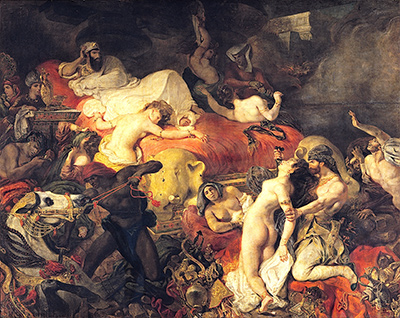The Death of Sardanapalus was completed in 1827 and is currently housed in the Musée du Louvre, located in Paris, France.
The subject matter of the painting, which is oil on canvas, was most likely inspired by Lord Byron's 1821 tragedy Sardanapalus, though Eugene Delacroix did not follow the text fully.
At the time the work was finished, society was quite outraged due to the graphic content, and as a result, it was not displayed again for many years.
The Assyrian ruler, Sardanapalus, has quite the backstory. Sardanapalus was the last king of Nineveh, a city in between the Mediterranean Sea and the Caspian Sea (present day Iraq).
While facing down a formidable enemy, Sardanapalus decided to take matters into his own hands and proceeded to destroy his own kingdom and possessions by fire. This included all his concubines, horses, wives and himself as well. Legend tells that he died in 876 BC.
Eugène Delacroix was born in, France, on April 26, 1798. He did his artistic training in Paris, and became a well-known figure in the early 19th century.
His father worked in foreign affairs, while his mother was a feature in the art scene. She emboldened Delacroix in his art, as a very cultured woman. Sadly, Delacroix had lost both by the age of 16.
Even at an early age, Delacroix was able to find buyers for his works. He portrayed subjects fraught with such extreme emotion, dramatic conflicts and violence, that even other artists were impressed.
He was even called a central figure in the Romantic era of French art. Although well renowned, the extreme emotional and often religious imagery of his work were sometimes maligned.
His strong connections with the movers and shakers of Romanticism France probably helped smooth some of the more ruffled feathers.
From around 1840, Delacroix became more reclusive, often spending most of his time in the countryside around Paris. His final commission was a set of murals for the Church of Saint-Sulpice in Paris. He died on August 13, 1863, in Paris.




